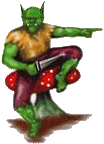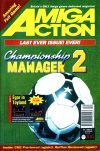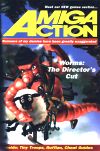

| First issue release
date: October 1989 |
Final issue release
date: December 1996 |
| Publisher: Europress
and IDG Media |
Coverage: Games
magazine |
| Country published:
United Kingdom |
No. of issues:
89 |
| Medium: Paper |
Status: Dead |
Web Address:
Bootleg
Amiga Action |
|
1989 - 1991: First Wave
As the longest running Amiga games magazine, Amiga Action has a
special place in Amiga folklore. Launched just a few months after
Amiga Format the magazine pre-emptied the Amiga boom of the early
1990's showing that the Amiga was more than a platform for
ST-ports.
In the early days Amiga Action symbolized a cut above the rest,
appealing to an uncharted market. The first issue, dated October
1989, was a 92 page glossy magazine aimed at the game player who
used the Amiga as an entertainment machine. This was a sharp
contrast to existing titles that perceived Amiga gaming as little
more than a distraction from more serious past times. Amiga Action
became one of the first magazines in the industry to define game
playing as a social occasion to be enjoyed alone or with friends.
This attitude was reflected in the review layout that were
non-linear in design. The primary focus was placed upon a basic
description of the game, with additional comments on the gameplay
itself scattered around the page. The layout was perfectly suited
to the game player, allowing the reader to quickly grasp the game
concept and if it was worth buying. Unusually for the time, reviews
were printed in full colour and included the commentary of two
reviewers. The rating system also followed this simple layout,
dividing into graphics, sound, and an overall percentage. It was
evident that games were rated mainly on their aesthetic qualities
rather than game playability.

In addition to the game reviews the magazine placed great emphasis
upon features and regular columns. The first issue included a
joystick round-up and a monthly game tips section titled 'Points of
Grue' that, rather unusually, included game pokes. This was
replaced in issue 3 by the more familiar 'Boggits Domain'. For the
readers who never 'experienced' the Boggit, it was a fictional
troll became infamous for making jokes at the expense of the Atari
ST. It remained one of the most popular sections of the magazine on
this basis.
    
During the next two years the magazine grew in parallel to the
Amiga market, rising to a whopping 164 pages in the December 1990
issue. The Amiga games boom had arrived bringing a new generation
of gamers. To cater for this market, the magazine introduced an
irregular coverdisk in issue 13 (October 1990), to compete against
their coverdisk-enhanced rivals. Response to this was favourable,
selling 6,000 more issues than previous, resulting in it becoming a
regular feature in January 1991 (AA16). The year (1991) became a
time of upheaval for the Amiga Action staff. The February 1991
issue marked the departure of editor Steve White, and the promotion
of Steve White in the April edition (AA19). Paul McIntyre became
assistant art editor and Peter Lee took the place of Alex Simon
(who had moved to the recently launched Games-X).
Super League
The Super League became a regular feature
that would extend over the magazine' life. At first it began as a
two page feature covering Adventure, Arcade Adventure, Arcade
Strategy, Strategy, Beat 'em up, Shoot 'em up, Flight simulators,
Role playing, Platform, Puzzle & quiz, Bat 'N' Ball. Land &
Sea simulators, and Racing & sport simulators.
Entry into the league table was based upon a
complex mix of overall percentage and age of the game, older title
became
devalued over time. |
These changes were followed by the magazines' first new look in
the February 1991 (AA17) edition. The cover design was more
professional, replacing the cartoon imagery of previous issues. The
layout became cleaner with greater use of columns and colour to
define different sections. The general magazine theme followed
American football, with high-rating games received the 'Super
League Accolade'. This was restricted to games that left a mark on
the software industry and would act as a yardstick for years to
come. The game would also be entered into the games Super League
table. However, its frequent use devalued the award over time. The
scattered rating system was replaced with a traditional 'Action
Info' box. This gave basic information on a game-title, publisher,
price, and programmer. The graphics and sound rating were also
reeling into the rating box. At this point Amiga Action was at its
peak, with a circulation figure of 58,404 (ABC July-Dec 1991). This
meant it sold more copies than any other Amiga games magazine,
beating its nearest rival, Amiga Power, by over 3,000. However,
competitors were beginning to amass and would begin to challenge
the magazine's control of the market. The gloss was about to
fade..
     
1992 - 1993: The Gloss Begins to Fade
For those who can remember it, 1992 was a time of hope - the
European Union was taking centre stage and the UK economy was
beginning to recover from recession. However, for Amiga Action the
year was associated with a gradual slip in standards. Criticism was
leveled, in particular, at the reviews - these were were purely
descriptive with little effort to evaluate the title. The Super
League was also coming under increasing attack from readers who did
not understand the system. These events came at a time when the
magazine's market share was being attacked from all sides. The
recently launched Amiga Power and The One for Amiga Games had begun
to challenge the established order and had begun to claim a sizable
portion of the market. It was clear that the magazine had to change
in order to survive.
These events unleashed a series of changes , beginning with an
improved design & layout in the April 1992 (AA31) issue. This
simplified magazine navigation and gave more room for the review
itself. The rating system was changed, abandoning the graphics and
sound scores, to concentrate on a single overall rating. Regular
sections were being given a spring clean, redesigning the letters
page and morphing the 'Project Inspection' preview section into the
more familiar 'Blue Print'. To pacify readers, the Super League
table was also dropped in favour of the 'Action Guide'. This was an
8 page regular that provided a brief description and screenshot of
the game. Finally, the magazine became spine-bound and stretched
the mast head to fill the cover (September - October 1992).
Despite the many changes, readership continued to fall. The
promotion of Alan Bunker to editor resulted in the magazine
undergoing another new look in the February 1993 (AA41) issue. The
Public Domain section was given a much needed revamp and the rating
system completely overhauled to give the complete 'low down' on the
game. The graphics and sound ratings returned, and were joined by
the addition of a score evaluating playability and difficulty, The
team also re-awoke to the need for a second opinion in game reviews
to give a balanced rating. This would be followed by the addition
of a third opinion in 1994. However, some things remained the same,
the Boggit continued to turn Atari ST jokes into an art form,
encouraging readers to write 'amusing' poems on the subject.
Rivalry between the two machines would remain heated until the
death of the ST market in 1994.
      
1993 - 1996: The Roudell Years
The Bunker editorship lasted just a few months, announcing his
departure, along with deputy editor Nick Merritt, in the September
1993 issue. The gap was quickly filled by Paul Roundell and Steve
McNally, who took the respective roles of editor and deputy editor.
The Roundell period bought a sense of stability to the magazine,
gradually moving away from the childish image to aim for a more
mature reader. However, while circulation figures had stabilized,
the magazine would never regain the number one position that it had
previously held. The magazine was still plagued by numerous
problems and new mistakes were being made that would gradually
alienate the reader.
Roundell's first issue in command saw the return of the Super
League. This represented a philosophical return to the magazine's
roots and what had made it great. However, there had been little
effort to understand why the feature had been canceled in the first
place, leading to repeated criticism from readers. Even the writers
quickly became tired of the column, and no one was entirely sure
how the league status actually worked. In addition, the column's
American football metaphor had began to look increasingly out of
place. The editor later commented that he regretted bringing the
column back. This mistake was followed by the introduction of 'Over
the Edge', written by Brad Burton. This was a brief attempt to
change Amiga Action into a lifestyle magazine, covering sports and
a range of non-computer subjects. The section was universally
criticized and was canceled after the June 1994 (AA55) edition.
      
The Commodore liquidation in April 1994 struck deeply at the
magazine. It is likely that Amiga Action would have continued to
evolve to a new state if the event had not occurred. However, the
growing uncertainty in the market had a dramatic effect upon the
magazine, causing its writers to give up hope. Rather than evolving
the magazine to better reflect the shrinking market, the writing
became sloppy and the page count began to drop. In the absence of
Amiga news, the childish humour that had plagued the magazine began
to take over. The repeated in-jokes and childish cover banners
quickly became an annoyance and further degraded opinion of the
magazine. The January 1996 (AA78) edition highlighted this,
announcing a 'special no sarcasm issue'. The tendency further
degraded the Amiga market fulfilling the stereotype that the Amiga
was a child's game machine. The magazines' only attraction during
this period was the coverdisk, that provided a regular stream of PD
games and demos. The magazine regularly increased to three cover
disks, and on the Christmas 1995 edition even beat that, with a
cover-buckling four disks.
During 1995 the magazine further courted controversy by
reviewing incomplete and PC versions of many games, a fact that
Amiga Power used to its advantages. It was clear that many writers
had began to view the Amiga market as a sinking ship and were eager
to dessert the vessel. This resulted in a continued loss of pages
and a rise in price during its final year, becoming a mere shadow
of its former self. Ironically, the magazine became number one
again, out-living its popular competitor, Amiga Power by two
months, becoming the last of the Commodore-Amiga game magazines.
The December 1996 edition, its 89th and final issue as an
independent publication, consisted of just 36 pages and retailed
for 4.50UKP.
The closure of Amiga Action was not the end of the story. As was
common practice by many Europress/IDG magazines, the dying title
was incorporated into another. This had already happened a few
years previous with the incorporation of ST Action into Atari ST
User. It was therefore unsurprising that Amiga Action was
incorporated into sister-title Amiga Computing. The new
incorporated version retained the basic Amiga Action design but
little of the writing style that had made it popular. The
arrangement continued for another ten issues during which the
market and the AA section continued to shrink. In September 1997
the final issue of Amiga Computing went on sale, featuring the even
leaner looking Amiga Action games section. Ironically it was the
99th edition of Amiga Action, a fact that was commemorated by its
death.
  
Subjectively, Amiga Action had never been the best Amiga games
magazine, but in its youth it had been a pioneer and a trendsetter
to the Amigas uncharted games market. By 1994 it had evolved into a
balanced title that had a loyal following of die-hard gamers.
However, the untimely death of Commodore led to growing uncertainty
in the market. The games developers were the first to go, along
with the game players whom were the magazines' core readership. The
loss of its parent sounded a death knell and the writers lost all
hope of the Amiga ever regaining its former glory.
BACK
|













